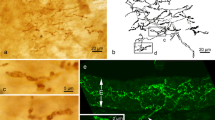Abstract
Immunohistochemistry for several neurochemical substances, the transient receptor potential cation channel subfamily V member 1 (TRPV1) and 2 (TRPV2), P2X3 receptor, and parvalbumin (PV), was performed on the nodose ganglion, pharynx, and epiglottis in human cadavers. The nodose ganglion was situated beneath the jugular foramen, and had a spindle shape with the long rostrocaudal axis. The pharyngeal branch (PB) issued from a rostral quarter of the nodose ganglion, whereas the superior laryngeal nerve (SLN) usually originated from a caudal half of the ganglion. In the nodose ganglion, sensory neurons were mostly immunoreactive for TRPV1 (89 %) or P2X3 (93.9 %). About 30 % of nodose neurons contained TRPV2 (35.7 %)—or PV (29.9 %)—immunoreactivity (-IR). These neurons mainly had small to medium-sized cell bodies, and were distributed throughout the ganglion. Neurodegenerative profiles such as shrinkage or pyknosis could not be detected in the examined ganglion. Occasionally, TRPV2-IR nerve fibers surrounded blood vessels in the epiglottis as well as in the nasal and oral parts of the pharynx. Isolated TRPV2-IR nerve fibers were also located beneath the epithelium. TRPV1-, P2X3-, or PV-IR nerve endings could not be detected in the pharynx or epiglottis. In the PB and SLN, however, numerous nerve fibers contained TRPV1-, TRPV2-, P2X3-, and PV-IR. The present study suggests that TRPV1-, TRPV2-, P2X3-, and PV-IR neurons in the human nodose ganglion innervate the pharynx and epiglottis through the PB and SLN. These neurons may respond to chemical, thermal, and mechanical stimuli during respiration and swallowing.




Similar content being viewed by others
References
Carobi C (1996) A quantitative investigation of the effects of neonatal capsaicin treatment on vagal afferent neurons in the rat. Cell Tissue Res 283:305–311
Caterina MJ, Schumacher MA, Tominaga M, Rosen TA, Levine JD, Julius D (1997) The capsaicin receptor: a heat-activated ion channel in the pain pathway. Nature 389:816–824
Caterina MJ, Rosen TA, Tominaga M, Brake AJ, Julius D (1999) A capsaicin-receptor homologue with a high threshold for noxious heat. Nature 398:436–441
Celio MR (1990) Calbindin D-28 k and parvalbumin in the rat nervous system. Neuroscience 35:375–475
Ebihara S, Kohzuki M, Sumi Y, Ebihara T (2011) Sensory stimulation to improve swallowing reflex and prevent aspiration pneumonia in elderly dysphagic people. J Pharmacol Sci 115:99–104
Guo A, Vulchanova L, Wang J, Li X, Elde R (1999) Immunocytochemical localization of the vanilloid receptor 1 (VR1): relationship to neuropeptides, the P2X3 purinoceptor and IB4 binding sites. Eur J Neurosci 11:946–958
Ichikawa H, Helke CJ (1995) Parvalbumin and calbindin D-28 k in vagal and glossopharyngeal sensory neurons of the rat. Brain Res 675:337–341
Ichikawa H, Sugimoto T (1997) Parvalbumin- and calbindin D-28 k-immunoreactive innervation of oro-facial tissues in the rat. Exp Neurol 146:414–418
Ichikawa H, Sugimoto T (2000) Vanilloid receptor 1-like receptor-immunoreactive primary sensory neurons in the rat trigeminal nervous system. Neuroscience 101:719–725
Ichikawa H, Sugimoto T (2001) VR1-immunoreactive primary sensory neurons in the rat trigeminal ganglion. Brain Res 890:184–188
Ichikawa H, Sugimoto T (2002) Co-expression of VRL-1 and calbindin D-28 k in the rat sensory ganglia. Brain Res 924:109–112
Ichikawa H, Sugimoto T (2003) The co-expression of VR1 and VRL-1 in the rat vagal sensory ganglia. Brain Res 980:293–296
Ichikawa H, Deguchi T, Nakago T, Jacobowitz DM, Sugimoto T (1994) Parvalbumin, calretinin and carbonic anhydrase in the trigeminal and spinal primary neurons of the rat. Brain Res 655:241–245
Ichikawa H, Xiao C, He YF, Sugimoto T (1996) Parvalbumin-immunoreactive nerve endings in the periodontal ligaments of rat teeth. Arch Oral Biol 41:1087–1090
Ichikawa H, Terayama R, Yamaai T, Yan Z, Sugimoto T (2007) Brain-derived neurotrophic factor-immunoreactive neurons in the rat vagal and glossopharyngeal sensory ganglia; co-expression with other neurochemical substances. Brain Res 1155:93–99
Kou YR, Lin YS, Ho CY, Lin CZ (1999) Neonatal capsaicin treatment alters immediate ventilatory responses to inhaled wood smoke in rats. Respir Physiol 116:115–123
Lang J, Nachbaur S, Fischer K, Vogel E (1987) The superior laryngeal nerve and the superior laryngeal artery. Acta Anat (Basel) 130:309–318
Lee LY, Ni D, Hayes D Jr, Lin RL (2011) TRPV1 as a cough sensor and its temperature-sensitive properties. Pulm Pharmacol Ther 24:280–285
Liu BY, Tsai TL, Ho CY, Lu SH, Lai CJ, Kou YR (2013) Role of TRPA1 and TRPV1 in the ROS-dependent sensory irritation of superior laryngeal capsaicin-sensitive afferents by cigarette smoke in anesthetized rats. Pulm Pharmacol Ther 26:364–372
Mathison R, Davison JS (1993) Capsaicin sensitive nerves in the jejunum of Nippostrongylus brasiliensis-sensitized rats participate in a cardiovascular depressor reflex. Naunyn Schmiedebergs Arch Pharmacol 348:638–642
Meller ST, Lewis SJ, Ness TJ, Brody MJ, Gebhart GF (1991) Neonatal capsaicin treatment abolishes the nociceptive responses to intravenous 5-HT in the rat. Brain Res 542:212–218
Michael GJ, Priestley JV (1999) Differential expression of the mRNA for the vanilloid receptor subtype 1 in cells of the adult rat dorsal root and nodose ganglia and its downregulation by axotomy. J Neurosci 19:1844–1854
O’Neil RG, Heller S (2005) The mechanosensitive nature of TRPV channels. Pflugers Arch 451:193–203
Ruan T, Lin YS, Lin KS, Kou YR (2006) Mediator mechanisms involved in TRPV1 and P2X receptor-mediated, ROS-evoked bradypneic reflex in anesthetized rats. J Appl Physiol 101:644–654
Sasaki R, Sato T, Yajima T, Kano M, Suzuki T, Ichikawa H (2013) The distribution of TRPV1 and TRPV2 in the rat pharynx. Cell Mol Neurobiol 33(5):707–714
Sato K, Hirano M (1997) Langerhans cells in the larynx and the hypopharynx. Kurume Med J 44:297–303
Selçuk B, Uysal H, Aydogdu I, Akyuz M, Ertekin C (2007) Effect of temperature on electrophysiological parameters of swallowing. J Rehabil Res Dev 44:373–380
Stefanini M, De Martino C, Zamboni L (1967) Fixation of ejaculated spermatozoa for electron microscopy. Nature 216:173–174
Conflict of interest
The authors do not have any conflict of interest.
Author information
Authors and Affiliations
Corresponding author
Rights and permissions
About this article
Cite this article
Sato, D., Sato, T., Urata, Y. et al. Distribution of TRPVs, P2X3, and Parvalbumin in the Human Nodose Ganglion. Cell Mol Neurobiol 34, 851–858 (2014). https://doi.org/10.1007/s10571-014-0062-9
Received:
Accepted:
Published:
Issue Date:
DOI: https://doi.org/10.1007/s10571-014-0062-9



